The first Jantar Mantar was built in Delhi with 13 instruments. Jantar Mantar in Jaipur is the largest of all the observatories with 19 astronomical instruments. This UNESCO world heritage site, which remained the major observatory of Sawai Jai Singh II until his death, has the largest stone dial in the world. Another one, with 13 instruments, was built in Ujjain, the holy city, which is also one of the sites for the famed ‘Kumbh Mela’ and lies on the tropic of cancer. This geographical feature of the city makes it an ideal choice to read the celestial movements, and the time recorded here is believed to be the most accurate among all.
 The observatory in Varanasi is built on the roof top of Mana Mahala (palace), offering views of the Ganges. Even though it is semi-functional, it can still be visited. Mathura was chosen as the site for the fifth Jantar Mantar. Unfortunately, the observatory here could not bear the test of times.
The observatory in Varanasi is built on the roof top of Mana Mahala (palace), offering views of the Ganges. Even though it is semi-functional, it can still be visited. Mathura was chosen as the site for the fifth Jantar Mantar. Unfortunately, the observatory here could not bear the test of times.
JAIGARH FORT (1726), JAIPUR
To protect the Amber Fort in Jaipur and the palaces within its complex, Maharaja Sawai Jai Singh II built the Jaigarh Fort in 1726 as a defensive structure to Amber fort.
 The Indo-Persian styled fort is surrounded by battlements and has a fortification of walls spread out three kilometers in length and one kilometer in width. Perched on the 'Cheelon ka Teela’ (Hill of Eagles) of Aravallis, the fort has a commanding view of Amber Fort and surrounding Aravallis.
The Indo-Persian styled fort is surrounded by battlements and has a fortification of walls spread out three kilometers in length and one kilometer in width. Perched on the 'Cheelon ka Teela’ (Hill of Eagles) of Aravallis, the fort has a commanding view of Amber Fort and surrounding Aravallis.
There are beautiful gardens, watchtower, latticed windows, and temples to be admired within the complex. Apart from this, the fort also had resources to harvest water.
Interesting Fact: Jaigarh fort was also a cannon foundry during the Mughal period. Here one can still see 'Jaivana’, which is believed to be the world's largest, wheeled cannon of its time. It is 6.15 meters long and weighs 50 tonnes. Its barrel is decorated with motifs of elephants, peacocks, and ducks.
THE CITY OF JAIPUR (1727)
With the growing population in Amber kingdom, problems like water scarcity started emerging, thus giving way for expansion. So, Maharaja Sawai Jai Singh II chose the site for his new capital, which was his former hunting ground. While his astronomical and scientific inclinations were known to everyone by then, planning of the city was just another feather added to his cap. He referred many books on architecture and finally planned the city on the lines of indian Fengshui which is called Vastu Shastra and Shilpa Shastra, both of which refer to the Indian sciences of architecture. The fortified area of the city with seven gates was divided into 09 blocks, similar to the number of planets in the Universe.
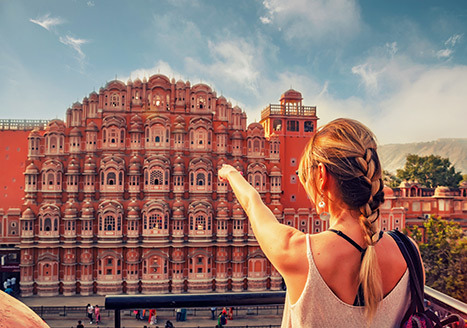
While two blocks were reserved for palaces and state buildings, the other seven were left for public settlements. The buildings were built in such a way that everything remains connected through the network of roads and streets.
One would be amazed to know that the layout of streets was in accordance with Sun and Moon's natural light and the direction of winds prevalent in the region. Different lanes leading to different blocks for particular occupational settlements were identified. The city which was planned and built in the year 1727, is functioning smoothly till date, unlike many other historic towns in different parts of the world. Today, the city needs no introduction as it has carved out its space in the world tourism as an integral part of the famed Golden Triangle (including Delhi, Agra, and Jaipur) circuit. Sawai Jai Singh II's walled city listed in UNESCO world heritage sites is an icon of architecture and culture.
CITY PALACE COMPLEX (1727), JAIPUR
When the shifting of capital from Amber Fort was planned, the construction of city palace also started simultaneously. It became the hub of religious, cultural, art and commerce activities.
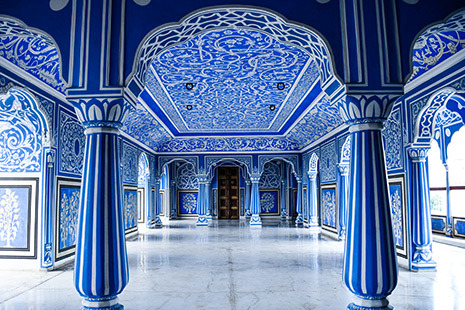
Maharaja moved his court to the city palace, and it acted as a seat of ceremonial and administrative proceedings until 1949, which marks the end of monarchy in India. The complex comprises several quarters, courtyards, gardens, pavilions, and temples.
A part of the complex is still occupied by the Royal family of Jaipur. It also houses a museum with galleries dedicated to different sections like Textiles, Paintings, Arms & Ammunition and Photography.
SISODIA RANI GARDEN AND PALACE (1728), JAIPUR
As soon as the city was built, it was dotted with many structures and water bodies over time to beautify it. One of those built by Sawai Jai Singh II is Sisodia Rani Garden and palace which was gifted to his beloved queen. The garden was named after the queen, who belonged to the Sisodia dynasty of Mewar. Built in the Mughal style the garden is surrounded by many waterways, fountains, sculptures, and pavilions. On the multi-layered top terrace of the garden there is a two-storeyed palace with lush green Aravalli hills in the backdrop.

The palace has many galleries and pavilions boasting of murals depicting stories of Lord Krishna and Radha, thus symbolizing the love of the king for his queen. The palace was built away from the hustle-bustle of the noisy city, so that queen could use it as a retreat to relax.
INTERESTING FACT: Jaipur is also known as the ‘Pink City’. While some believe that the city was painted pink because of Sawai Jai Singh's liking towards terra cotta colour, others believe that it was painted in pink to resemble the color of red sandstone, which was the most popular colour of the Mughal. However, the most popular belief is that the city was painted pink as a mark of hospitality to welcome HRH Albert Edward, Prince of Wales (who later became King Edward VII, Emperor of India), in 1876 by Sawai Ram Singh I.
NAHARGARH FORT (1734)
Built as a royal retreat on the summit of Aravallis by Sawai Jai Singh II, this fort with Indo-European styled architecture offers breath-taking views of the city. The fort has many palaces, temples, and beautiful gardens within the complex, thus making it an ideal choice for the royal family members to be used as a summer retreat. The fort was never attacked in its history and many structures were added by the subsequent rulers of the same lineage. There is also a ‘Nahargarh Biological park’ and ‘Sculpture park’ within the fort complex.
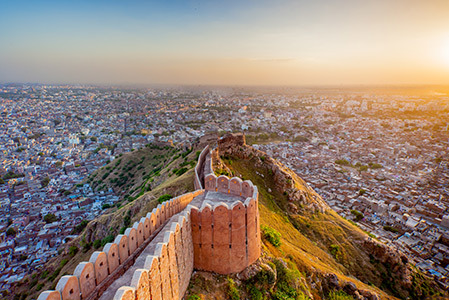
Initially named Sudarshangarh Fort, it was renamed Nahargarh which means 'abode of tigers', due of the frequent visit of tigers around this place. There is also a legend associated with its current name, according to which Prince Nahar Singh's spirit disrupted the fort's construction.
Later a temple dedicated to him was built, and the fort was renamed, Nahargarh Fort. The walls of the fort connect with those of Jaigarh, thus making them interconnected with each other.
GAITORE KI CHHATRIS (CENOTAPHS)
The Chattris (Cenotaphs) are the places where the royal family members used to be entombed or cremated. They are usually made of white marble and display a distinct style of architecture with open pavilions and ornate domes that are supported by sculpted pillars. Apart from the beautifully laid cenotaphs, Gaitore ki chattris also make a picturesque setting with Aravallis in the backdrop.
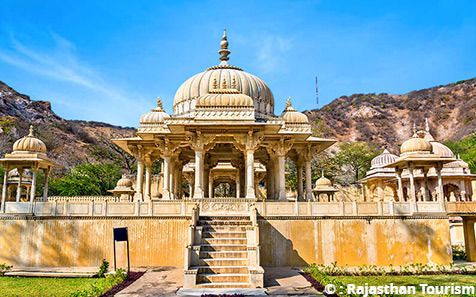
Maharaja Sawai Jai Singh II chose this place for royal cremations when the capital was shifted to Jaipur. The term Gaitore is believed to have been derived from the Hindi word ‘Gaye ke Thor's’, which means the final resting place of souls.
It was only about one king of India. India has a very extensive rich history which has witnessed the rise and fall of various glorious dynasties. The incredible land has many such royal stories waiting to be explored. Come and experience these historic trails with us! We, at Indo Asia Tours, are all about the handcrafted tours, memories, and moments you take out of your trip, and believe us, this escapade will be a life-changing one!

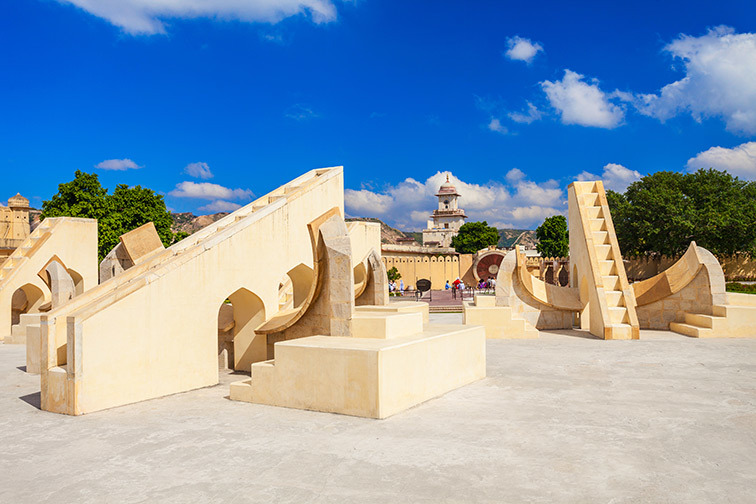
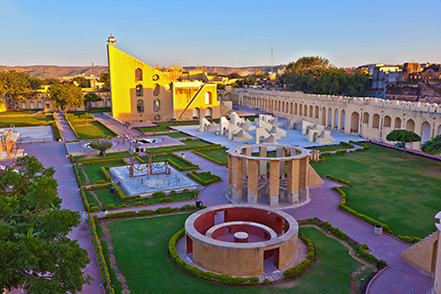 Contrary to existing instruments completely made up of brass, he came up with masonry structures that gave a fairly accurate reading with naked eyes, at the time when Europe observed such readings using the telescope.
Contrary to existing instruments completely made up of brass, he came up with masonry structures that gave a fairly accurate reading with naked eyes, at the time when Europe observed such readings using the telescope.
 The observatory in Varanasi is built on the roof top of Mana Mahala (palace), offering views of the Ganges. Even though it is semi-functional, it can still be visited. Mathura was chosen as the site for the fifth Jantar Mantar. Unfortunately, the observatory here could not bear the test of times.
The observatory in Varanasi is built on the roof top of Mana Mahala (palace), offering views of the Ganges. Even though it is semi-functional, it can still be visited. Mathura was chosen as the site for the fifth Jantar Mantar. Unfortunately, the observatory here could not bear the test of times.
 The Indo-Persian styled fort is surrounded by battlements and has a fortification of walls spread out three kilometers in length and one kilometer in width. Perched on the 'Cheelon ka Teela’ (Hill of Eagles) of Aravallis, the fort has a commanding view of Amber Fort and surrounding Aravallis.
The Indo-Persian styled fort is surrounded by battlements and has a fortification of walls spread out three kilometers in length and one kilometer in width. Perched on the 'Cheelon ka Teela’ (Hill of Eagles) of Aravallis, the fort has a commanding view of Amber Fort and surrounding Aravallis.
 While two blocks were reserved for palaces and state buildings, the other seven were left for public settlements. The buildings were built in such a way that everything remains connected through the network of roads and streets.
While two blocks were reserved for palaces and state buildings, the other seven were left for public settlements. The buildings were built in such a way that everything remains connected through the network of roads and streets.
 Maharaja moved his court to the city palace, and it acted as a seat of ceremonial and administrative proceedings until 1949, which marks the end of monarchy in India. The complex comprises several quarters, courtyards, gardens, pavilions, and temples.
Maharaja moved his court to the city palace, and it acted as a seat of ceremonial and administrative proceedings until 1949, which marks the end of monarchy in India. The complex comprises several quarters, courtyards, gardens, pavilions, and temples.
 The palace has many galleries and pavilions boasting of murals depicting stories of Lord Krishna and Radha, thus symbolizing the love of the king for his queen. The palace was built away from the hustle-bustle of the noisy city, so that queen could use it as a retreat to relax.
The palace has many galleries and pavilions boasting of murals depicting stories of Lord Krishna and Radha, thus symbolizing the love of the king for his queen. The palace was built away from the hustle-bustle of the noisy city, so that queen could use it as a retreat to relax.
 Initially named Sudarshangarh Fort, it was renamed Nahargarh which means 'abode of tigers', due of the frequent visit of tigers around this place. There is also a legend associated with its current name, according to which Prince Nahar Singh's spirit disrupted the fort's construction.
Initially named Sudarshangarh Fort, it was renamed Nahargarh which means 'abode of tigers', due of the frequent visit of tigers around this place. There is also a legend associated with its current name, according to which Prince Nahar Singh's spirit disrupted the fort's construction.
 Maharaja Sawai Jai Singh II chose this place for royal cremations when the capital was shifted to Jaipur. The term Gaitore is believed to have been derived from the Hindi word ‘Gaye ke Thor's’, which means the final resting place of souls.
Maharaja Sawai Jai Singh II chose this place for royal cremations when the capital was shifted to Jaipur. The term Gaitore is believed to have been derived from the Hindi word ‘Gaye ke Thor's’, which means the final resting place of souls.
 We can conduct a virtual destination awareness training program for your team or yourself or a virtual tour for your clients. Let us know the destination of your interest along with your convenient date / time and we will be happy to set up a program for you.
We can conduct a virtual destination awareness training program for your team or yourself or a virtual tour for your clients. Let us know the destination of your interest along with your convenient date / time and we will be happy to set up a program for you.

